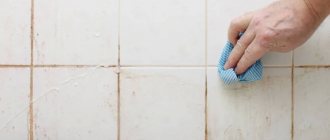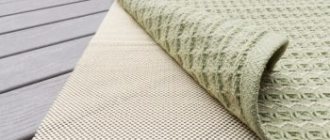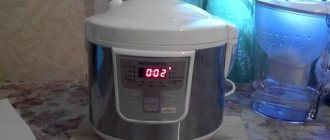Sooner or later, all owners of laminate flooring have to look for a convenient way or means to fix cracks in the laminate. No matter how accurately the lamellas are laid and pressed tightly, still after a year or two thin and narrow holes appear at the joints. It’s good if signs of a future gap are identified when laying the laminate, in this case it can be corrected without the use of special means, but more often you still have to deal with the problem after the lamellas have settled on the substrate.
The cracks must be removed urgently, otherwise the laminate will become unusable
Why do cracks appear in laminate flooring?
There are not many reasons why joints between lamellas increase or holes form, and most of them are related to the process of laying the coating. In order for cracks to appear in the laminate, the panels must move relative to each other. This happens due to three reasons:
- The lock is not completely closed; as a result of under-pressure or failure to tamp the lamellas when laying the laminate, gaps remain between the slats. The easiest way to correct the situation is at the stage of assembling the laminate, but you can try and simply seal the gap after the fact;
- The lock is broken due to the joint hanging above the substrate. Most often this happens when the line coincides with the seam between the pine needle backing sheets;
- Improper subfloor preparation. If all depressions and “humps” are not corrected before installation, then over time the substrate will settle and the laminate will shift, forming cracks.
In addition, holes in the laminate flooring may appear due to improper installation technology. For example, craftsmen may leave or forget to seal the gap between the laminate and the wall. With a floor width of 3-4 m, due to thermal expansion, the material can easily diverge by 8-10 mm.
Some of the slats may need to be removed
In any case, regardless of the reasons why cracks appeared in the laminate, the situation must be urgently corrected before moisture reaches the substrate and the end surface of the planks. It is clear that you will need to inspect the entire coating in order to identify places where the lamellas are subsiding, determine the number of holes, select a material and a method to correct the damage.
Damage to the laminate
Damage classification
High-quality laminate itself is a durable material that withstands mechanical stress well. But in some situations, especially if mistakes were made when laying the floor or operating conditions were violated, the laminate cannot withstand and fails.
Among the most common damage to laminate flooring are:
- Gaps between laminate planks;
- Swelling of the laminate in conditions of high humidity;
- Scratches;
- Chips, holes and other damage caused by mechanical impact.
But whatever the defect, even the smallest scratch spoils the appearance of the entire floor covering (as can be seen in the photograph). For this reason, the faster and better the damage that occurs is repaired, the better it will be.
Helpful information. The majority of cracks and scratches can be easily repaired on your own
But before doing this, it is important to find out why the defect occurred and then decide on the method of repairing the laminate
How to remove cracks in laminate flooring
In this situation, the determining factor is not the size of the hole between the slats, but the number of slots. The width of the hole can vary depending on the temperature and load on the laminate, but if in one room there are more than five points of divergence of joints with a total width of more than 20-25 mm, then it is urgent to dismantle the covering.
Preparing how to fix the situation at the lowest cost
Usually the situation is partially saved by furniture. Wardrobes and heavy wardrobes, furniture walls are fixed on one side so that the seams do not open. All small pieces of furniture, sofas, armchairs, chairs, tables are taken out of the room. Next, you need to determine the direction of dismantling the laminate.
Important! If the laminate panels simply come apart, then only part of it will need to be disassembled, from the wall to the point where the first joint is opened. In a situation where broken locks are discovered, in order to fix the damage, you will have to disassemble all the slats down to the broken board.
It is not necessary to remove the coating one strip at a time. You can fasten them with tape and dismantle them in entire sections. You just need to mark the panels and try to do the work with maximum accuracy.
Before trying to correct the divergence of joints, you need to perform a small revision:
- Check the condition of the substrate and try to find out the cause. It is important not only to fix the gap, but also to eliminate the source of its appearance. These could be trimmings of the lining, pieces of the slab, or simply garbage forgotten on the lining. All this needs to be removed with a vacuum cleaner;
- The second stage is to inspect the locks; they also need to be cleared of debris. After which, with your hands, without a hammer, you check how deep the connection is closed;
- If there is a chipped tenon on the lamella, it will need to be replaced; any gluing or attempts to cover up a hole in the laminate or fix the damaged area with even the strongest glue do not yield results.
The laminate lock must remain movable and allow the lamella to expand. You can try to fix the spike with a PVC film insert. Otherwise, at the first serious load or temperature change, a hole will appear again in the restored area.
Part of the rotten lamella is cut out and a patch is glued in
Repair, how to fix a gap with a hammer and a pry bar
After the inspection, the slats need to be laid in the reverse order. Usually the tongue and groove of the lock are lubricated with sealant on the back side. You can fix the coating without gluing, given the fact that the laminate is not designed for repeated assembly and disassembly, it is still better to play it safe and use silicone. This will make the locks tighter.
Individual planks are hammered through a wooden block, onto the end of which a strip of soft and thick leather is glued. To eliminate the gap, apply a series of gentle blows, moving the block along the bar.
Sealing cracks by interrupting
There is another way to fix the joints; you don’t even have to disassemble the coating. In order to tighten the separated joints, use a mounting tool and a long wooden or aluminum beam or rail, the edge of which is pressed against the opposite wall. Using it as a stop, the lamellas are carefully pressed down with a mounting tool and the connection is completely seated.
This method is convenient for correcting joints at the short ends of the planks, especially if the place is located close to the wall.
The ends are supported by a stop
Why use laminate sealant?
Processing laminate joints is far from gluing. This gives it additional resistance to water. Modern laminate of normal quality is made moisture resistant. That is, simply spilled and cleaned up water does not have any visible effect on it. And of course, it can be wiped with a damp cloth.
But regular laminate flooring is not waterproof. That is, the water must be removed from the floor. Otherwise, having leaked through the joints and absorbed into the base (which is simply cellulose pressed under pressure, that is, paper), moisture will cause dimensional distortion. After drying, wet dies do not return to their original state. They remain crooked, with raised edges. Cannot be restored. You can only replace them with new ones.
To avoid such a picture, when laying the seams, they are coated with special products.
That is, the laminate will warp only if moisture penetrates through the locks into the base of the coating. Manufacturers also understand this and produce waterproof laminate. Its base is water-repellent, and the locks are impregnated with water-repellent agents. These can be oil- and polymer-based formulations.
But the price of moisture-resistant laminate is high, but treating joints with sealant is quite inexpensive. It’s clear that you won’t be able to achieve the same water resistance as factory products. But moisture resistance will become much higher.
How to seal cracks in laminate flooring
It doesn't always make sense to dismantle the flooring to fix one or two defects. Sometimes a small section of a tenon is simply broken in place, and it is simply not physically possible to replace the entire lamella.
The cracks must be treated, otherwise the hole will appear again
Therefore, you can fix or seal the gap with plastic compounds:
- Sealant to match the color of the laminate;
- Grouting compound based on wax and sawdust;
- Seal with cork;
- Fix the joint using a proprietary repair compound.
Important! The worst way is to try to fix the joint using regular glue and settling of the strip. If the cause of the gap has not been eliminated, then before the adhesive mass sets, the lamellas will return to their original state.
The damage will remain, but it will be permanently sealed. In general, experts do not recommend using any brand of glue; the laminate only loses its mobility and breaks at the seams. An exception may be a gap between the laminate and the door frame or wall; in this case, the ends of the lamellas must be firmly secured.
Sealing the gap with acrylic
Repair with sealant
The most reliable way to correct the situation is to close the gap between the edges of the laminate using a ready-made acrylic wood repair compound. There are a dime a dozen such mixtures on sale; it is only important that the repair material is intended specifically for wood. As a rule, this is a plastic tube for a syringe gun; this tool is convenient to use if you need to fix a gap between a hard and soft surface.
To seal the gap, first of all you need to stick transparent wide tape onto the joint line. This will help not to stain the laminate and avoid a long and unpleasant procedure for cleaning it from sealant residues.
After sticking the tape, carefully cut it with the tip of a sharp knife. You need to cut with your hand without pressure, almost by weight, so as not to damage the lock or, even worse, not to cut the lining, then it will be much more difficult to fix the seam.
Moving along the cut line, fill the gap with sealant
Next we apply sealant. To prevent the film from interfering with the movement of the tip, we wrap a regular wallpaper nail onto the nozzle. When moving, the edges of the tape rise, rather than wrapping inside the joint.
Advice! Craftsmen recommend that before pressing in the sealant, slightly spread and wedge the gap. After filling with repair mixture, the wedges are removed and excess material is squeezed out of the joint.
After the mixture has dried, cut off the top of the seam and remove the tape. One way to remove cracks in laminate flooring is shown in the video:
Cork repair
For laminates laid loosely on a substrate, it is important to maintain movement and expansion. For such coatings, it is recommended to correct cracks with “liquid plug”. This is a mixture of sealant and cork chips. You can buy it or make it yourself. The cured material is very soft and elastic, so it can be used to easily fix any cracks and joints.
Gap problems at the walls or at the front door can be corrected with cork tape. “Liquid plug” is not used for these purposes. The tape is cut to length and thickness, glue is applied and pressed into the gap.
Joint between tiles and laminate
A combination of these materials is most often used:
- In the hallway and kitchen. Laminate is not damaged by water and its wear resistance increases.
- To divide a room into zones.
- In doorways.
There are several ways to join tiles and laminate:
Application of grout
Tile grout is applied at the junction of tiles and laminate. It can be bought at any hardware store. The grout color is chosen based on the colors of the floor coverings and the color scheme of the room. You can choose plain or contrasting shades.
Installing a cork compensator
For this, a strip of cork is used, which easily takes the desired shape. It can be used on smooth and wavy joints. The soft structure allows the cork to shrink and fill narrow areas.
Application of sealant
When sealing seams, a construction gun is used, with which the sealant from the tube is squeezed into the cracks between the tiles and the laminate. The components of the sealant protect the laminate by preventing moisture absorption.
The disadvantage of this method is that the sealant has only one color - brown. This color does not go well with all flooring shades.
How to fix a hole in laminate flooring
Nightmarish situations happen when you not only need to seal a thin and narrow gap, but also fix more serious damage, for example, repairing a hole in the laminate flooring.
The easiest way is to use a branded repair compound, for example, “Quilosa” or something similar. It is easy to use and does not require special training. All you need to do is choose the right color, seal the edges of the hole with tape and rub the hole with repair paste.
Grouting with acrylic putty
Sometimes it is simply not possible to use special means due to their lack. In this case, you can donate a piece of laminate and rub sawdust from it. In order to fix a hole, you will need twice as much sawdust as the amount of damage itself. Mix the material with wood glue heated in a water bath and use a spatula to press the mixture into the hole.
To completely correct the damage, the hardened patch is carefully ground and polished with a felt attachment on a screwdriver. All that remains is to remove the tape and traces of glue.
Tips for repairing slats
In each specific case, the method of restoration and the amount of work that needs to be performed depends on the severity of the damage: the depth and area of the chip, crack or scratch. When carrying out work, you must adhere to the following recommendations:
- All repair work must be done as soon as a minor defect appears: this makes it easier to repair.
- Any composition for laminate restoration should be applied carefully, while capturing the edges of the damage.
- After finishing work, the laminate must be wiped with a damp cloth.
To further protect the laminate from damage, it can be coated with a layer of clear varnish.
High-quality laminate from well-known manufacturers is a rather expensive floor covering. Therefore, it must be treated with the utmost care. It is best to walk on such a floor in house slippers, do not move heavy furniture on it and do not drop heavy objects. In this case, the laminate will last the entire period declared by the manufacturer without breakdowns or complaints. Laminate, despite its high degree of resistance to stress and abrasion, is sometimes damaged
Most often this happens when careless handling of heavy objects or products whose edges are quite sharp. As a result, cracks, scratches, dents and chips form on the laminate
To eliminate them, improvised and special means are used.
Preventing cracks in laminate flooring
The formation of damage at joints can only be prevented by periodic inspection of the joints. Moreover, it is best to start prevention at the stage of assembling the laminate. If the master is a professional, then it is better not to get on his nerves and let him do his job calmly.
In other cases, you need to regularly inspect the coating and try to fix the seams before the locks break. Cracks most often form as a result of water spilled but not removed in time, so it is better to prevent the edges from being squeezed out than to try to correct the defect later.
Mastic treatment reduces the risk of damage
How to deal with “playful” boards?
This kind of trouble happens for two reasons: the incorrect pitch of the lag is to blame, or the wrong boards were chosen - the material is too thin. There are also two ways out - installing additional logs or installing thicker boards. Both of them are not very attractive, since they involve dismantling the floor covering. Yes, these options are optimal, but there is a simple way - rallying adjacent elements with dowels. It makes it possible to stop the “play” of the tree and eliminate the deflection.
This operation is not so simple, because there are many nuances in it.
- Correctly drilling holes at an angle is the first problem. It is necessary to ensure that there is a sufficient layer of wood between the fasteners and the lower/upper plane of the boards. The angle of inclination is selected based on the thickness of the material.
- Diameter of holes for fasteners. It should be at least 0.5 mm larger than the dowels. The remaining gap will be filled with glue (stationery PVA), which cannot be squeezed out. It will promote swelling of the fibers, so the connection will become reliable and super strong.
- Drill and template. The length of the tool must be maximum, but finding a suitable option is very difficult. There is a possible solution: welding a rod of the same diameter. The template will greatly speed up the work, especially at the “beginning of glorious deeds.”
- Sprayer for glue. It is made from a tube of diameter suitable for the spout of the bottle. The length of the segment is 20 cm. The tube is sealed at one end, and small holes are made in it, which will not allow the glue to stain everything around.
Dowels soaked in glue are installed in holes also treated with the compound. The connections are left alone until dry. The raised part of the chops is removed with a grinder, and the cut is polished with what is at hand - the same angle grinder, a hand grinder, or a drill with an appropriate attachment, but at low speeds.
The question of how to seal cracks in the floor can now be considered closed
Since the choice of suitable material largely depends on the depth and width of the flaws, the owners will have to decide: any means will do, and it doesn’t matter at all whether they are popular or purchased. However, the best way out is to unite the sexes
In this case, the cracks will no longer appear, which means you don’t have to be afraid that at one “wonderful” moment all the “good” that was carefully stuffed in will fall out again.
One of the options for transforming a cracked floor can be seen in this video:
How to mask cracks in laminate flooring
There are only two ways to hide the repair site. Firstly, use special wax compounds, which are usually used to fix scratches and abrasions. If you regularly treat the area, then over time the stain will merge in texture with the main background of the floor.
Secondly, you can seal the hole with film cut from the remains of the laminate. This process is complex and requires skill in working with a grinder, but in terms of texture quality it is the best. You can fix it with vinyl self-adhesive, but the masking effect is much worse.











